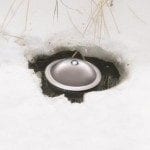Your cart is currently empty!
Get Event Reminders…
…twice a month by subscribing to our newsletter
Subscribe using the form in the page footer below.
Your cart is currently empty!
…twice a month by subscribing to our newsletter
Subscribe using the form in the page footer below.
Distractions happen, and things fall to the wayside. This year we were in the process of getting a new 2-acre pond ready for prime time, and we didn’t get things in our koi pond ready to go for the cold months nearly as early as we normally try to. So, it’s nearly December and you haven’t gotten everything ready to ensure an easy Spring. There’s still plenty that you can do now to make sure that you haven’t done too much damage to your pond ecosystem.
Assuming that you haven’t put up your net yet, you should definitely grab your skimming net and get to work. Clean out everything that you can without risking hypothermia. All of that organic debris will decompose slowly when it’s cold, but once things warm up it will go fast, adding tannins to your water (which leads to the dreaded tea-colored water), throwing off all of your pond’s water health balances, and adding to your sludge layer.
Even in winter, partial water changes can help to provide healthier, less polluted water for your be-finned friends. Do this very carefully, though, changing water much less aggressively than you would in warmer times. Slower winter metabolisms potentially means that your pond recovers from water changes less quickly. Don’t change out more than 5% of your water a week, preferably less, and be sure that the temperature of the water your adding is equalized to that in the pond before you add it.
Slower winter metabolisms don’t just affect larger animals and plants. Even bacteria slow way down, and that means that the beneficial bacteria in your pond aren’t cleaning it the way they do in warm months. Supplementing your system with special cold water adapted bacteria will go a long way toward making your Spring a happier experience.
Cold Water Fish Food
Unless you’re unusually scrupulous about cleaning up the rest of your yard, chances are that there are still leaves and other organic debris waiting to fall or in a position to be blown into your pond. The right pond net can save you considerable problems.
 A pond surface that’s completely covered with ice closes off gas exchange between the pond and the surrounding air, which can cause buildup of all kinds of things in the pond and lead to oxygen deficiency. Keep the water at least partially open using an aerator (my preferred method) or a heat source. if your pond does ice over, DO NOT break up the ice by hitting it with anything. Because water resists compression and therefore transmits kinetic energy very efficiently, the shock from the hit, even a relatively mild one, can hurt or even kill your fish, even if they’re nowhere near where you hit the ice. Just don’t do it. Use mild heat or a drill to get through the ice.
A pond surface that’s completely covered with ice closes off gas exchange between the pond and the surrounding air, which can cause buildup of all kinds of things in the pond and lead to oxygen deficiency. Keep the water at least partially open using an aerator (my preferred method) or a heat source. if your pond does ice over, DO NOT break up the ice by hitting it with anything. Because water resists compression and therefore transmits kinetic energy very efficiently, the shock from the hit, even a relatively mild one, can hurt or even kill your fish, even if they’re nowhere near where you hit the ice. Just don’t do it. Use mild heat or a drill to get through the ice.
Header image by Martin Schmidt.
Logging in to comment gives you more features, but it is not required.
American Elder provides an incredible summer floral display. At least 50 species of songbirds relish its fruit. Discover more.
Chamomile tea and green tea are among the 7 teas and herbs that reduce anxiety and improve sleep which we discuss here.
Annuals for container gardening are great for novice gardeners or anyone who wants to add interest and colour to their porch or patio.
Contribute to a brighter future for our region: Join us in protecting the spectacular flora and fauna of the Riviera Nayarit and Puerto Vallarta. Conservation not only benefits wildlife, but people too!
Lance-Leaved Figwort is a pollinator magnet providing a lot of nectar for bees, butterflies, and hummingbirds! Read the Quick Growth Guide.
Immerse yourself in the vibrant world of Art in the Garden at Kiwi Gardens. Marvel at moving sculptures, colorful glasswork, and stunning woodwork. Get inspired for your own garden and explore a wide variety of unique plants. Don't miss this amazing experience!
The devastating effects of deforestation are long-lasting and far-reaching with the power to impact all living things.
If you are starting from scratch, here are some great houseplant starters. They are easy-to-grow and require little maintenance.
Swamp milkweed thrives in swampy areas and wet meadows. It is a monarch butterfly host plant and is essential to their life.
Climbing hydrangeas are great because they can be grown in any climate and add beauty to any landscape, and they are also easy to care for.
Give your garden an update this season with wintergreen – featuring gorgeous, white bell-shaped flowers and bright, pinkish-red berries. Its glossy, evergreen foliage adds beauty, and it makes an excellent ground cover for shady areas. Plant wintergreen to enjoy it’s vibrant ground cover and fragrant, evergreen foliage!
GardeningCalendar.ca gets some funding from advertisers. If you click on links and advertisements at no cost to you, the site may receive a small commission that helps fund its operation.
© 2025 J&S Calendars Ltd.